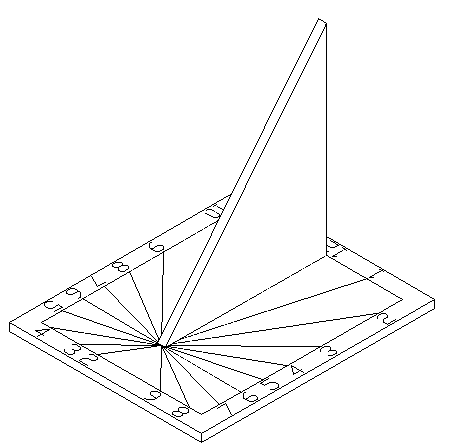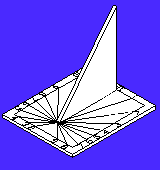 |
|
richardandtracy's Sundial Design Page.
This article is about making a small sundial.

Why Sundials? Well, making a sextant got me thinking about the uses the sun can be put to, and after reading around the subject, I came to the conclusion that a sundial would make a nice little project for someone to put together. They can be as simple as anything. The biggest problem is the calculation involved - which is solved by the use of a program.
How does one tell the time from the sun?
I shall now launch into a very brief non-technical explanation of what goes on with telling the time from a sundial. It's non-technical as the technical stuff is very well catered for on other sundial sites.
In its simplest form (and we'll work up from there) imagine that the sun rotates around the earth once every 24 hours. That is, it passes through 360 degrees of revolution every 24 hours. Or 15 degrees every hour. So, the shadow of an object parallel to the axis about which the sun rotates can be used to tell the time. This is called a gnomon (silly word, I didn't invent it, so don't blame me!).
The practicality of having a gnomon floating in thin air and having an invisible shadow angle measuring device is dealt a further practical blow by the fact that the earth is not transparent, so it usually won't work for 24 hours a day. The simplest, practical shape is a horizontal plate and an angled gnomon - as shown in the diagram above. The gnomon points due north in the northern hemisphere, and due south in the southern hemisphere. (Note that compasses only rarely point North/South as the magnetic poles do not coincide with the real poles, and the magnetic poles move about too.)
Now, having decided on a horizontal dial, this has introduced extra complication. The shadow cast by an angled gnomon on a horizontal plate doesn't move evenly every hour, so the standard 15 degrees per hour has to be modified by the gnomon angle (the latitude of the sundial) and the time from mid-day. Local mid-day always sees the gnomon shadow due North-South, and at local 6am/6pm the shadow is always due East-West, but the intervals between are not constant. The intervals can be calculated, however. They are a pain to do by hand though.
Now you need to decide what sort of time you want your sundial to tell you. Unless it is deliberately altered, a sundial tells you the local apparant time where you are (LAT). This is not necessarily the same as the time in your time zone. For example, I live at 0'43'40.8" East. My watch, in winter, is set to GMT (based around the local time at 0'0'0"), so the sundial appears to read 3 minutes fast. In summer, a daylight saving time is used, so the time zone moves ahead 1 hour to the local apparant time at 15'0'0"E. Thus, in summer, the discrepancy due to the timezone is such that the dial reads 57 minutes slow. This time zone discrepancy can be taken up on the dial, by shifting the labels for the hours. It is a neat solution, but it causes even more calculation.
Now, the final complication. The sun doesn't actually rotate around the earth. And the orbit isn't circular, it's an elipse, so the earth travels faster for parts of the year compared to others. This leads to a phenomenon where the dial reads slow or fast by up to 16 minutes, 23 seconds. This is called the 'Equation of Time' (EQT). The EQT is a correction factor that's different every day rather than a mathematical equation (when it was named 200 odd years ago the words meant slightly different things). The EQT is not something that can be catered for in a simple horizontal dial like the one covered by this article, so we've just got to live with it.
All this talk of calculation.. "It's too hard", I hear the faint cry on the wind. Well, you're sitting at a huge calculator every time you use your computer. Why not use it? To ease the calculations for you, I've written a Windows program to draw you the dial shown above, however your dial will be tailored for your timezone, longitude and latitude.
Program
A program to draw a dial for your latitude, longitude and timezone is available for download here.
Download the Sundial Face Generating Program. (197 kb)
You will need to enter the following data into the program:-
Latitude
Longitude
Time Zone (from a list)
The latitude and longitude need to be as good as you can get. Look at a map of 1:25000 or better if you can.
The program then produces a dxf drawing file of the resulting dial, similar to the one below:-

The dxf file can then be edited/ plotted in a CAD program. There are numerous free CAD programs that could be used. If you haven't got one, look on the front of a PC magazine or do a web search for one.
Making the Sundial
At its simplest, plot the output from the program on to some card. Cut out the gnomon, stick it perpendicularly to the dial along the line drawn from the dial centre (where the hour lines radiate from) to the point vertically above it in the diagram [NOT the 12 o'clock line, the one next to it]. Then turn the dial around until the time it reads is the same as a wrist watch.
You could engrave all the lines and numbers on a piece of brass using the engraving tool shown in the tools section of my sextant design. The gnomon could then be soldered (silver solder is stronger) perpendicular to the dial. The top of the gnomon should be as thin as possible - so if you use a thick piece of brass, file or machine it down a little. An alternative to filing the gnomon is to separate the west and east halves of the dial by the width of the gnomon - which will have the same effect.
If you make a sundial out of brass, make the effort to position it correctly. The dial must be as flat as you can get, with the gnomon axis due North/South.
And that's all there is to it.
If you make a sundial to the design shown here I'd be pleased, and very gratified, if you were to let me know (e-mail address on the Biography page). However, please fill in the subject line sensibly, as I tend to delete e-mails from unknown senders without reading them.
Richard Williams.
March 2004.
|

Hits since 26 March 2004
|
| |
© Mar 2004 Richard Williams
| | |

